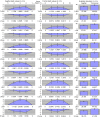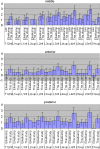Geometry of the intervertebral volume and vertebral endplates of the human spine
- PMID: 19876738
- PMCID: PMC2803258
- DOI: 10.1007/s10439-009-9827-6
Geometry of the intervertebral volume and vertebral endplates of the human spine
Abstract
Replacement of a degenerated vertebral disc with an artificial intervertebral disc (AID) is currently possible, but poses problems, mainly in the force distribution through the vertebral column. Data on the intervertebral disc space geometry will provide a better fit of the prosthesis to the vertebrae, but current literature on vertebral disc geometry is very scarce or not suitable. In this study, existing CT-scans of 77 patients were analyzed to measure the intervertebral disc and vertebral endplate geometry of the lumbar spine. Ten adjacent points on both sides of the vertebrae (S1-superior to T12-inferior) and sagittal and transverse diameters were measured to describe the shape of the caudal and cranial vertebral planes of the vertebrae. It was found that the largest endplate depth is located in the middle or posterior regions of the vertebra, that there is a linear relationship between all inferior endplate depths and the endplate location (p < 0.0001) within the spinal column, and that the superior endplate depth increases with age by about 0.01 mm per year (p < 0.02). The wedge angle increases from T12-L1 to L5-S1. The results allow for improvement of the fit of intervertebral disc-prostheses to the vertebrae and optimized force transmission through the vertebral column.
Figures





Similar articles
-
[Study on anatomical parameters of adult lumbar intervertebral disc and endplate based on CT].Zhongguo Gu Shang. 2023 Jan 25;36(1):72-8. doi: 10.12200/j.issn.1003-0034.2023.01.014. Zhongguo Gu Shang. 2023. PMID: 36653011 Chinese.
-
Morphometry of the lower lumbar intervertebral discs and endplates: comparative analyses of new MRI data with previous findings.Eur Spine J. 2016 Dec;25(12):4116-4131. doi: 10.1007/s00586-016-4405-8. Epub 2016 Feb 12. Eur Spine J. 2016. PMID: 26873104
-
Association Between Measures of Vertebral Endplate Morphology and Lumbar Intervertebral Disc Degeneration.Can Assoc Radiol J. 2017 May;68(2):210-216. doi: 10.1016/j.carj.2016.11.002. Epub 2017 Feb 16. Can Assoc Radiol J. 2017. PMID: 28216287
-
L5-S1 Achromobacter xylosoxidans infection secondary to oxygen-ozone therapy for the treatment of lumbosacral disc herniation: a case report and review of the literature.Spine (Phila Pa 1976). 2014 Mar 15;39(6):E413-6. doi: 10.1097/BRS.0000000000000195. Spine (Phila Pa 1976). 2014. PMID: 24384664 Review.
-
Solitary bone plasmacytoma of spine with involvement of intervertebral disk: a case report and literature review.Skeletal Radiol. 2024 Aug;53(8):1651-1656. doi: 10.1007/s00256-024-04566-x. Epub 2024 Jan 17. Skeletal Radiol. 2024. PMID: 38231261 Review.
Cited by
-
Digital tomosynthesis and high resolution computed tomography as clinical tools for vertebral endplate topography measurements: Comparison with microcomputed tomography.Bone. 2015 Dec;81:300-305. doi: 10.1016/j.bone.2015.07.033. Epub 2015 Jul 26. Bone. 2015. PMID: 26220145 Free PMC article.
-
Micro-CT evaluation of asymmetrical ovine intervertebral disc height loss from surgical approach.Eur Spine J. 2017 Aug;26(8):2031-2037. doi: 10.1007/s00586-017-5024-8. Epub 2017 Mar 13. Eur Spine J. 2017. PMID: 28289843
-
Multiscale structural characterization of the vertebral endplate in animal models.J Anat. 2021 Jul;239(1):70-80. doi: 10.1111/joa.13402. Epub 2021 Jan 31. J Anat. 2021. PMID: 33521970 Free PMC article.
-
Sagittal endplate morphology of the lower lumbar spine.Eur Spine J. 2012 May;21 Suppl 2(Suppl 2):S160-4. doi: 10.1007/s00586-012-2168-4. Eur Spine J. 2012. PMID: 22315035 Free PMC article.
-
Changes in Lumbar Endplate Area and Concavity Associated With Disc Degeneration.Spine (Phila Pa 1976). 2018 Oct 1;43(19):E1127-E1134. doi: 10.1097/BRS.0000000000002657. Spine (Phila Pa 1976). 2018. PMID: 29596278 Free PMC article.
References
-
- Eijkelkamp, M. F. On the Development of an Artificial Intervertebral Disc. PhD-thesis, University of Groningen, 2002.
-
- Lee, C. K. Intervertebral Disk and Nucleus Prosthesis. Patent US2008046082, 2003.
MeSH terms
LinkOut - more resources
Full Text Sources

